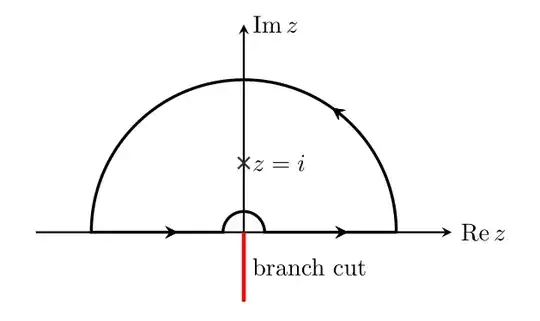One way to attack this particular problem is to make the substitution $x=t^2$, as in Ahlfors, Complex Analysis, Third Edition, p. 159; the integral becomes
$$\int_{-\infty}^{\infty} dt \: \frac{t^2}{t^4+1} $$
We may now use a semicircular contour $C$ in the half plane $\Re{z} \ge 0$ rather than the annulus as we have disposed of the branch point at the origin. We write
$$ \oint_C dz \: \frac{z^2}{z^4+1} = i 2 \pi \left ( \mathrm{Res}_{z=e^{i \frac{\pi}{4}}} \frac{z^2}{z^4+1} + \mathrm{Res}_{z=e^{i \frac{3 \pi}{4}}} \frac{z^2}{z^4+1} \right ) $$
$$\begin{align} \mathrm{Res}_{z=e^{i \frac{\pi}{4}}} \frac{z^2}{z^4+1} &= \frac{e^{i \frac{2 \pi}{4}}}{\left (e^{i \frac{\pi}{4}}-e^{i \frac{3 \pi}{4}}\right )\left (e^{i \frac{\pi}{4}}-e^{i \frac{-3 \pi}{4}}\right )\left (e^{i \frac{\pi}{4}}-e^{i \frac{-\pi}{4}}\right )} \\ &= \frac{i}{i (1-i)(2) \left (2 i \sin{\frac{\pi}{4}} \right )} \\ &= -i \frac{1+i}{4 \sqrt{2}} \end{align}$$
Similarly,
$$ \mathrm{Res}_{z=e^{i \frac{3 \pi}{4}}} = -i \frac{1-i}{4 \sqrt{2}} $$
Therefore,
$$ \oint_C dz \: \frac{z^2}{z^4+1} = i 2 \pi (-i) \frac{1}{2 \sqrt{2}} = \frac{\pi}{\sqrt{2}} $$
Now, about the contour $C$ which has a large radius of, say, $R$:
$$ \oint_C dz \: \frac{z^2}{z^4+1} = \int_{C_R} dz \: \frac{z^2}{z^4+1} + \int_{-R}^R dt \: \frac{t^2}{t^4+1} $$
In the limit as $R \rightarrow \infty$,
$$\int_{C_R} dz \: \frac{z^2}{z^4+1} \sim \frac{\pi}{R} $$
and therefore vanishes. We may then conclude that
$$\int_{-\infty}^{\infty} dt \: \frac{t^2}{t^4+1} = \int_0^{\infty} \frac{\sqrt{x}}{x^2+1} = \frac{\pi}{\sqrt{2}} $$
